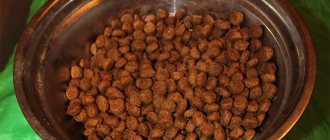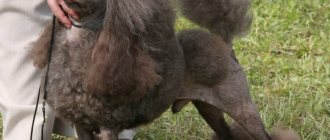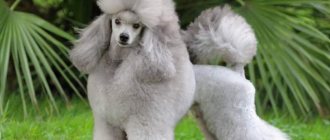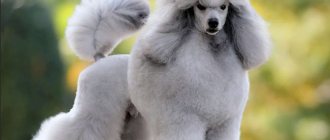Looking at a toy poodle, it’s hard to believe that this is a living creature - it looks very much like a plush dog with button eyes and charming curls.
It fully corresponds to its name (toy - from English toy). Undoubtedly, like any other breed, it has both advantages and disadvantages. And here's what the owners think about this.
Breed traits
Breed traits (on a 5-point scale)
| Toy poodle | |||
| Activity | in the house | 3.2 | |
| on the street | 3.2 | ||
| Obedience | training | 4.1 | |
| strangers | 4 | ||
| Domination | in family | 1.9 | |
| over dogs | 2.7 | ||
| Defending your territory | from people | 2.6 | |
| from dogs | 2.9 | ||
| Sociability | in family | 4.8 | |
| with strangers | 3.8 | ||
| with dogs | 3 | ||
| Concentration | in family | 1.2 | |
| in front of strangers | 1.7 | ||
| with dogs | 1.5 | ||
| Aggressiveness | in family | 1.3 | |
| to strangers | 1.8 | ||
| to the dogs | 2.4 | ||
| to cats | 2.3 | ||
| Family behavior | calmness | 4.4 | |
| demand for affection | 5 | ||
| excitability | 4.3 | ||
| playfulness | 4.3 | ||
| excessive barking | 2.6 | ||
| behavioral breakdowns | 1.7 | ||
| Tolerance for children | up to 4 years | 2.9 | |
| over 4 years old | 3.6 | ||
| Institutional use | watchman | 4.5 | |
| bodyguard | 2.4 | ||
This breed is often compared to the following dog breeds: Bichon Frize, Pomeranian, Yorkshire Terrier, Maltese (Maltese Bichon), Papillon.
The photo shows what a toy poodle looks like:
Appearance of a Toy Poodle dog
List of nicknames
For an original mini-dog, choose a name that suits its appearance or character. It is necessary to avoid long words with a lot of consonants that sound rude. Pets are often called affectionately, tenderly, or with exotic intonations.
Common nicknames for male dogs: Arto, Arsen, Archie, Buckley, Basil, Barney, Waltz, Harry, Count, Dustin, Jazz, Zhulbert, Fuse, Zigmund, Zorik, Indigo, Lucky, Lel, Lawrence, Mike, Nils, Nord, Olaf , Orpheus, Austin, Paco, Pele, Peach, Rice, Sally, Tonic, Fidel, Elvis, Janek.
Names for females: Agata, Adele, Assol, Alisa, Alma, Amalia, Beata, Bella, Businka, Valerie, Vega, Viola, Gabi, Glasha, Denise, Diana, Dina, Dora, Eva, Giselle, Zara, Zizi, Zita, Toffee, Lada, Laura, Lucy, Nicole, Richie, Selina, Tori, Ulya, Utah.
Description of the toy poodle breed
This variety of poodles appeared only in the 20th century, but quickly gained popularity among lovers of decorative dogs. The prefix “toy” in the name translates as toy. This little dog really looks like a plush toy. Soft curly fur, lively expressive eyes and a harmonious physique make her attractive.
But by nature, this is not a decorative pet that will lie on the sofa all day. This is an active and curious companion. The dog is very people-oriented. He will follow his owner everywhere, strives to participate in all his affairs and is very bored without attention.
| Options | Characteristic |
| breed name | toy poodle |
| country of origin | France |
| usage | dog companion |
| life expectancy | 15-18 years old |
| height | 24-28 cm |
| weight | 4-6 kg |
| activity | very active, playful, cheerful |
| aggressiveness | not aggressive at all |
| attitude towards a person | loyal, good-natured, love children, cannot stand loneliness |
| intelligence | very smart, easy to train |
| difficulty of care | light shedding, but difficult to care for |
| security qualities | warn of danger with loud barks |
Pros of the Toy Poodle breed
The breed is young, but quickly became popular throughout the world. These miniature dogs are ideal for keeping in a small apartment. The toy poodle also has other advantages:
- good-natured, not aggressive, love all people;
- become attached to the owner and members of his family, affectionate and sociable;
- love children and are tolerant of their tricks;
- get along with other pets;
- very smart and obedient, easy to train;
- character is cheerful, friendly;
- attractive appearance;
- They shed little, the fur is hypoallergenic and odorless.
Disadvantages of the Toy Poodle breed
But before you get a toy poodle, you need to get acquainted with the disadvantages of the breed:
- these dogs are in poor health;
- they bark a lot and loudly;
- cannot stand loneliness;
- very mobile, active, need long walks;
- Difficult coat care, requires regular trimming;
- do not like to communicate with other dogs, early socialization is required;
- They can be cowardly, nervous, afraid of loud sounds.
Differences from other varieties of poodles
It is difficult to distinguish the toy poodle from another type of breed - the miniature poodle. The differences between them are little noticeable. In addition to size, these varieties differ in the severity of the occipital protuberance; in toys it is less noticeable. Another difference is the softer wool. Toy poodles, like many miniature breeds, have a fragile build and poor health.
But this breed does not show signs of dwarfism. Even from a large poodle they differ only in size. But the body proportions and other standard requirements are the same.
A miniature version of the toy poodle was bred in Japan. It differs from the others in size and weight. These dogs grow up to 22 cm and weigh about 3 kg. They have a fragile skeleton and poor health. This variety is not recognized as a standard and is not allowed for breeding.
Advantages
An important advantage of all representatives of the breed is devotion, goodwill and strong love for their owners . Dogs demand attention and reciprocate. The miniature poodle will be an excellent friend, a loyal and reliable companion. Other positive aspects of the breed include:
- absence of a specific “dog” smell ;
- developed mind (dogs are easy to train);
- allowed for allergy .
Reference! The toy poodle is a good athlete . The handsome miniature loves to jump and run, and he deftly overcomes the obstacle course. This is an active and cheerful animal.
Most Miniature Poodles retain the hunting habits of their older cousins, the Royal Poodles. These dogs are also wary of strangers. When meeting strangers, most representatives of the breed will bark in defense of the owner.
History of the origin of the Toy Poodle breed
Poodles have been popular for centuries. But earlier in European countries large representatives of the breed were bred - measuring 45-60 cm at the withers. They were valued for their high intelligence and working qualities. Large poodles were used for hunting, guarding, patrol and search service, they helped people in rescue operations and in war.
But gradually their attractive appearance made poodles popular among the nobility. They began to be bred as decorative dogs. Therefore, breeders began to breed smaller representatives of the breed. The main objectives of selection were to reduce the size and increase the decorative appearance. They succeeded. At the beginning of the 20th century, a toy poodle standard was created in France, and this breed variety was recognized by the FCI.
Photo gallery
Before you get yourself a pet toy poodle, think about whether you are ready to devote enough of your time and attention to its upbringing and maintenance.
Appearance of representatives of the Toy Poodle breed
This breed is young, the standard has been edited many times. The latest version was approved in 2007. According to this standard, the size of a toy poodle should be 24-28 cm. The ideal height at the withers is 25 cm, but if an adult dog is below 24 cm, it will be disqualified. These miniature representatives of the breed are very sickly.
These dogs weigh 3-5 kg, the weight of a male can reach 6-7 kg. The physique is harmonious, there should be no signs of dwarfism (short muzzle, sharp stop).
Head
The head is proportional to the body. The skull is convex, the brow ridges are well defined. The muzzle is elongated, fox-like, but not narrow. The stop is little noticeable, the bridge of the nose is straight. The lobe is wide, black. Apricot or red colored dogs may have brown hair. The lips are tightly closed, the cheekbones are flat, and the bite is scissor-shaped.
The eyes are slightly slanted and set wide apart. The look is open and cheerful. Color from amber to dark brown. The ears are hanging, rectangular elongated in shape. The tips are rounded and reach the lips. Covered with long hair.
Body and tail
The neck is muscular, the scruff is pronounced. The case format is rectangular, tapering towards the waist. The back is straight, the croup is rounded. The chest is deep, reaching the elbow joints. The abdomen is moderately tucked. The tail is set high and covered with long hair. It rises up, but does not curl into a ring.
Limbs
The limbs are straight, of medium length, set parallel. The joints are well defined, strong, the thighs are muscular. The paws are oval, gathered into a ball, with small membranes between the toes. The movements are light and springy.
Coat and color
The coat of these dogs is thick, soft, and long. The hairs are thin, there is no undercoat, they shed once in a lifetime. The coat can be wavy, elastic, with pronounced curls or corded. But the second option is rare among toys, unlike other representatives of the breed.
The standard allows several varieties of colors:
- pure black;
- white - such dogs are sometimes born apricot, and after molting the coat becomes lighter;
- gray or silver, this color develops with age;
- rich brown;
- red, apricot or red.
Spots are not allowed in any color variant. Apricot and red colored dogs may become lighter in color as they age. In some countries, poodles are bred in two other colors: black and white (harlequin) and tan (phantom). But they are not recognized as a standard.
Photos complement the description of the appearance of these dogs:
Character and education of Toy Poodle dogs
Toy poodles are loyal dogs that become attached to their owner. They are very sociable and cannot stand being alone. This dog constantly requires human attention. She feels his mood, is sad or happy with him, and can adapt to the habits and lifestyle of the owner. With proper upbringing, he is a calm, reserved dog. He understands facial expressions and gestures and does not impose himself when the owner is not in the mood for him.
This is an ideal pet for old and young people, singles or large families. But you should not get this breed for someone who is often not at home. Without communication, the toy poodle becomes nervous, can become depressed, and will spoil things out of boredom.
These dogs get along well with children and other pets. They are patient, good-natured and obedient, ready to support all the child’s games. But you should not leave the dog alone with the baby - he has a fragile constitution, careless handling can lead to injuries.
Some representatives of the breed can be stubborn, capricious, and jealous. They are mischievous and do not always obey. But they are not prone to dominance, are not touchy or vindictive. For these dogs, the main thing is human attention and affection.
Training
Despite its attractive appearance, the toy poodle is more of a companion than a toy dog. He needs early socialization and proper upbringing. This is a smart, quick-witted dog and is easy to train. But an ill-mannered poodle can grow up to be cowardly, nervous or aggressive.
From the first days of arrival in the house, the puppy must be taught:
- sleep in your place;
- respond to a nickname;
- do not beg for food;
- do not bark often;
- walk with a collar and leash;
- relieve yourself in a diaper or on the street.
The baby must be introduced to strangers, cars, and the smells of the street. He should not be afraid of loud noises or other dogs.
Up to 6 months, the dog needs to be taught the basic commands: “sit”, “lie down”, “come to me”, “place”, “stand”, “no”, “fu”, “walk”. It is also advisable to learn the “be silent” command, since poodles are prone to loud barking. Gradually, training can be made more complex: teach how to respond to gestures, teach tricks.
Toy poodles love to exercise, if they are praised, they are ready to follow all the orders of the owner. But training needs to be structured in the form of a game and varied, as the dog may get bored. The main method of training is encouragement, affection, and treats. Physical punishment and roughness are contraindicated. The dog will become timid, cowardly and nervous. If the dog does something forbidden, he can be reprimanded in a stern voice or deprived of play.
Disadvantages of a shaggy pet
Experts involved in breeding dwarf poodles identify several negative qualities in the character, behavior and lifestyle of dogs. The disadvantages of this breed are:
- Long and difficult adaptation to new living conditions . Moving to a new house traumatizes the shaggy friend’s psyche. What can we say about changing the owner.
- Poodle health . The animal's body may suffer from the development of chronic diseases. Many pathologies are inherited. Your pet may need regular or lifelong medical care.
- The animal's fur needs constant and high-quality care . Taking care of your pet's physical needs includes bathing your pet weekly and trimming its coat once every two months.
- Dwarf poodles are afraid of loud noise and do not tolerate the company of unfamiliar animals or people.
- Dogs need regular physical training . Therefore, the owner of a poodle should allocate time for playing and training the pet. Moderate physical activity has a positive effect on the health of your shaggy companion.
Maintenance and care of Toy Poodle dogs
This is a decorative dog for home keeping. After buying a cheek, he needs to allocate a place to sleep, put a house or a bed there. You need a separate place for eating - there should always be a bowl of clean water there. It is recommended to buy your puppy a lot of different toys - toy poodles are very active, they sleep little during the day and love to play.
Although this miniature dog can be diaper trained to go to the toilet, he must be taken for a walk. Toys need new experiences and active games. It is advisable to walk 2-3 times a day for at least half an hour. Several times a week, it is recommended to take your pet to dog parks or take it out of town so that it can freely frolic without a leash. But you need to take into account that toy poodles do not like to communicate with other dogs.
Hygiene procedures for these dogs are simple:
- wash your paws and belly every time after a walk;
- fully bathe once every 1-2 months;
- brush your teeth once a week;
- Trim the nails as they grow;
- several times a week, wipe your eyes and clear your ears of discharge;
- treat wool from parasites monthly in the warm season.
Grooming
Toy poodles shed heavily once in their lifetime. After this, the hairs change constantly and fall out little by little. If you brush your dog regularly, this will not be noticeable; there will be no hair anywhere.
The peculiarity of caring for poodles is that they need to be cut regularly - approximately once every 1-1.5 months. If the dog is not being shown, a hygienic haircut is sufficient. In this case, the hair on the face, paws, groin, and under the tail is shaved. In summer, it can be shortened on the body, then the dog will not be so hot.
There are many decorative haircuts for poodles. But dogs that participate in shows are only allowed a few options.
- Lion - short hair on the back half of the body to the ribs and on the muzzle. There is a long mane on the neck. Cuffs are made on the limbs, and a pom-pom on the tip of the tail.
- Modern – the hair on the body is trimmed evenly. It is short on the face, belly and paws.
- Scandinavian clip – similar to modern. The difference is that the tail, paws and ears are shaved.
- Pappy clip – the front of the body is like a ball. The paws, muzzle and tail are shaved, and there is a crown on the head.
There are also other decorative haircuts: bichon, kennel, bikini, lamb. They are used for dogs that do not show. You can groom your pet yourself or contact a professional groomer.
The photo shows how you can cut a toy poodle's hair:
Nutrition
Representatives of this breed have a poor appetite and eat little. Therefore, you need to choose foods that are rich in nutrients. These dogs can be fed both natural products and dry food. An adult dog should eat 2 times a day. Portion – 60-65 g per 1 kg of natural food weight or 20-40 g/kg of dry food per day.
When choosing natural feeding, you need to provide all your pet’s needs for proteins, fats, carbohydrates and microelements. The diet should include:
- lean meat, offal - at least 50% of the daily value;
- eggs and sea fish 2-3 times a week;
- buckwheat, rice or oatmeal;
- fresh and boiled vegetables;
- dairy products;
- in small quantities vegetable oil, herbs, fruits.
You should not give your dog fatty foods, spicy, salty, smoked or fried foods. Sweets, baked goods, potatoes, legumes, onions, grapes, and mushrooms are prohibited. On the recommendation of a veterinarian, you can additionally add vitamins or fish oil to your food.
Dry food is more convenient for those owners who often travel with their pet or take it to exhibitions. This diet contains all the necessary microelements. There will be no need to give additional vitamins. It is recommended to choose super-premium or holistic class food. It is advisable to buy options designed for small breeds. If the diet is unsuitable, the poodle may develop allergies, stomach diseases, and dermatitis.
Health
Toy poodles are long-lived. On average, they live for at least 15 years, and with good care they can live up to 18 years. But you need to take into account that their health is poor, so regular visits to the veterinarian for preventive examinations are important. It is necessary to treat your pet for worms in a timely manner and receive all vaccinations required by age.
These dogs are prone to allergies and dermatological diseases. Due to their small size and fragility of the skeleton, they are often injured. Representatives of the breed may experience the following pathologies:
- diabetes;
- hypothyroidism;
- urolithiasis disease;
- epilepsy;
- eye diseases;
- otitis;
- blood clotting disorder;
- displacement of the kneecaps.
Reviews
Interesting information can be obtained from owners of unique miniature dogs:
Nonna. St. Petersburg: “Knowing about my allergy to wool, I chose a toy poodle consciously. A year later, I can state that this is a miracle, giving only positive things to the family. After communicating with a pet, performance increases and mood improves.”
Ulya. Saratov: “My little pet is three years old. We give our toy poodle a haircut every two months, turning him into a spectacular lion cub. No one remains indifferent. We rarely take part in dog shows, but we always take prizes. Most importantly, our pet quickly became a selflessly loyal and devoted friend to all family members.”
Ksenia. Pskov: “We contacted the nursery without yet knowing what breed we wanted. When we saw the tiny, curious toy poodle puppies, we couldn’t pass them by. At home, our Leo quickly settled in. The dog does not confuse the toilet with a bed. True, you have to hide your shoes from your pet. The poodle plays with pleasure, but does not like to walk for a long time.”
How to buy a Toy Poodle puppy
If you want to buy a toy poodle, you need to contact a kennel that specializes in this type of breed. Puppies are difficult to distinguish from toy, medium and even royal poodles. They have the same structure, and the difference in height becomes noticeable with age. In Moscow, the price of representatives of this breed starts from 10 thousand rubles. A show class dog can be bought for 30-50 thousand rubles.
When choosing a puppy, you first need to study the living conditions of the animals, the behavior and health of the mother. It is desirable that she does not have genetic diseases. Puppies must have a veterinary passport and all vaccinations required by age.
It is recommended to choose an active, cheerful and not cowardly baby. It is important to pay attention to the following signs:
- eyes are clean, without discharge, dark in color;
- the coat is shiny and thick;
- no unpleasant odor;
- skin without ulcers and scratches;
- the physique is harmonious, without signs of exhaustion;
- the stomach is soft, not bloated.
An interesting video will complement the characteristics of the breed and help you understand whether such a dog is worth getting:
Video: Toy poodle - All about the dog breed
Video: Review of the Toy Poodle breed
Video: Toy poodle - Interesting facts about the breed
The Toy Poodle is a small dog with an attractive appearance and a loyal character. She is capable of becoming a loyal friend to any person who will love her and pay attention to her. This smart, cheerful dog can give a lot of joy.
Diseases and health problems
Small breed dogs often get sick. The Toy Poodle is considered a relatively healthy breed, but is still susceptible to some diseases.
The most common diseases of toy poodles:
- A congenital defect of the fusion of the nasal passages, in which the animal experiences severe snoring and difficulty breathing. It can only be treated with surgery;
- Heart diseases. To reduce the risk of disease, it is important not to physically overload your pet and protect it from stress;
- Eye diseases. Most often, such dogs have cataracts, conjunctivitis, retinal atrophy, glaucoma, and entropion. Most eye diseases are passed on to offspring genetically and have almost no cure. Older dogs often begin to see poorly or become completely blind;
- Epilepsy. Another hereditary disease that is diagnosed at a tender age and is associated with increased excitability of the animal. Epilepsy can either progress during the animal’s life or be in remission;
- Diabetes. The endocrine system, in particular the pancreas, is the weakest point of all small dog breeds. Diabetes is not directly inherited, but genetic predisposition plays a role;
- Oral diseases. Toy poodles, especially with age, suffer from stomatitis and gingivitis. The cause of the disease is insufficient oral care and poor nutrition;
- Otitis. The direct reason here is the shape of the ears, which does not allow them to be fully ventilated. If fluid gets inside a dog's ear, it can easily develop inflammation. An important preventive measure against otitis media is proper and timely ear hygiene;
- ICD (urolithiasis). It manifests itself as a result of a serious metabolic disorder, which is caused by the accumulation of salts in the body and their improper elimination, thereby provoking the appearance of stones in the bladder and kidneys.
Also, small dog breeds suffer greatly from various viruses. Therefore, strict adherence to the vaccination schedule is very important for them.











